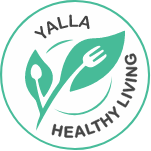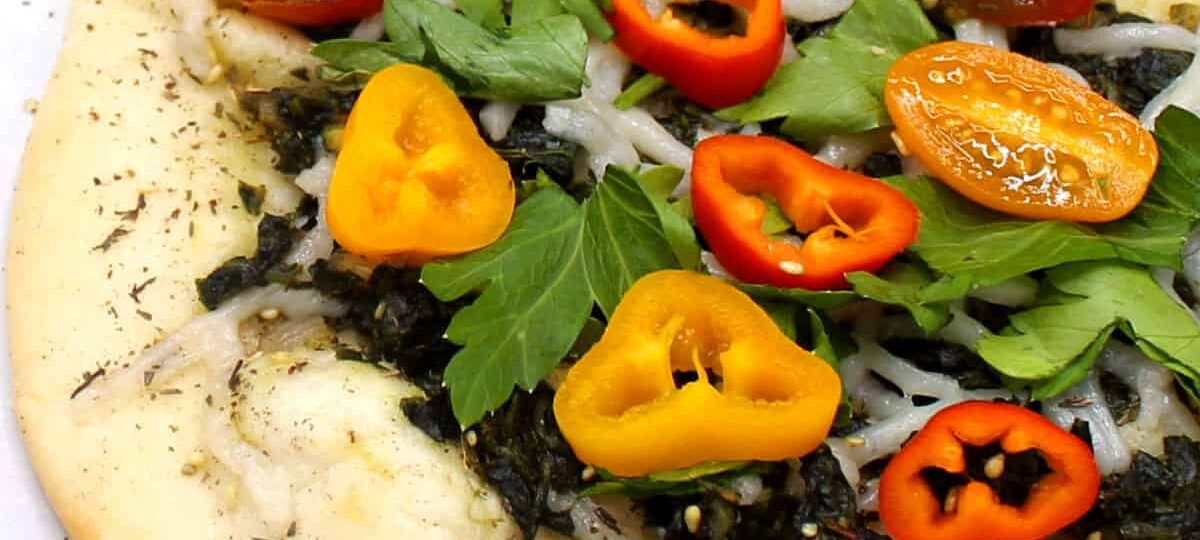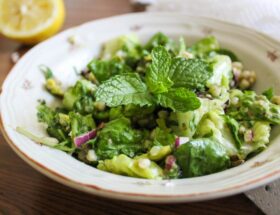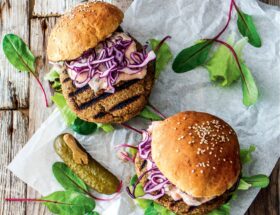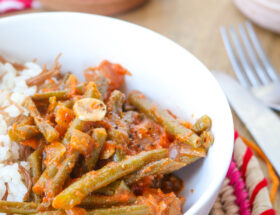Manakish (also called manoush/mankousheh/manoushe/za’atar bread) is a puffy, pizza-like Lebanese flatbread that’s baked with the addictive middle eastern herb and spice mix, za’atar, then stuffed with veggies. It’s often eaten as a wrap for breakfast, but it makes a delicious meal for anytime. My vegan version has a flavorful, smoky spinach filling and it is stuffed with cherry tomatoes and sweet peppers.
Earlier this week, on what happened to be World Mankousheh Day, my Armenian-American friend Margo shared a memory of eating this beloved Lebanese flatbread where she grew up, near Beirut. She’d visit the bakery with her dad, she wrote, and on the way home in the car, sneak a few bites of the still warm Mankousheh.
I had never eaten this bread before, and it looked so pizza-like, Jay was entranced. So I set about trying my hand at making it with some inspiration from David Tanis who, in this article, says they are a common offering at Lebanese food stands in Parisian markets.
As it turned out, making manakish couldn’t have been easier, and the result was a gorgeously flavorful and fun breakfast that I — and Jay, I think — could eat every day.
The manakish dough is very much like a pizza or naan dough. You leaven it with yeast, let it rise, then stretch it by hand or roll it as thin as you can. You spread it with a flavorful mix of olive oil and za’atar and bake it in an oven where it puffs and crisps up, becoming quite divine.
What is za’atar?
Za’atar or zahtar is a widely used Middle Eastern herb mix. You will most likely find it in your supermarket or online (I will add an affiliate link in the recipe box to the brand I use). It is usually made with dry za’atar leaves, a plant in the mint family, sesame seeds, and sumac, a bright red powder made by crushing wild sumac berries, among other ingredients.
Apparently there are as many variations of this herb mix as there are families. Margo wrote that the za’atar toping is special in this dish because there are so many varieties or combinations of spices; in fact, in Lebanon, it was, and probably still is traditional for families to bring their own special Zaatar mixture to the baker who would then use it to create their special Mankousheh, she said.
I love za’atar and always keep it on hand to sprinkle into my favorite dishes like this Eggplant Hummus, this No-Oil Roasted Eggplant Soup and this Squash Dip. And although mine is just the bottled kind I buy off the shelf or online, I love the smoky, lemony flavor it adds to nearly anything. Yum.
Making the dough
The bread itself needs just five ingredients–yeast, water, sugar, flour and extra virgin olive oil. As always, start out by blooming the yeast in the water, add the flour, and make sure that you knead it into a dough that’s just slightly sticky but smooth.
Lebanese Chickpea StewRoasted Carrots with Za’atarRoasted Squash Dip With Za’atarArbi Paratha, a Vegan, Gluten-Free FlatbreadVegan Pita Packets With Broccoli and TofuEasy Aloo Kulcha, a Potato-Stuffed Indian Flatbread (with sou…Eggplant Hummus with Za’atarRoasted Eggplant Soup with Za’atar (No Oil)
Manakish, a Lebanese Flatbread with Za’atar
Posted on November 12, 2020 (Updated on September 6, 2021) Jump to Recipe Pin Recipe
Manakish (also called manoush/mankousheh/manoushe/za’atar bread) is a puffy, pizza-like Lebanese flatbread that’s baked with the addictive middle eastern herb and spice mix, za’atar, then stuffed with veggies. It’s often eaten as a wrap for breakfast, but it makes a delicious meal for anytime. My vegan version has a flavorful, smoky spinach filling and it is stuffed with cherry tomatoes and sweet peppers.

Earlier this week, on what happened to be World Mankousheh Day, my Armenian-American friend Margo shared a memory of eating this beloved Lebanese flatbread where she grew up, near Beirut. She’d visit the bakery with her dad, she wrote, and on the way home in the car, sneak a few bites of the still warm Mankousheh.
I had never eaten this bread before, and it looked so pizza-like, Jay was entranced. So I set about trying my hand at making it with some inspiration from David Tanis who, in this article, says they are a common offering at Lebanese food stands in Parisian markets.
As it turned out, making manakish couldn’t have been easier, and the result was a gorgeously flavorful and fun breakfast that I — and Jay, I think — could eat every day.https://imasdk.googleapis.com/js/core/bridge3.480.1_en.html#goog_1228449711Volume 0% https://31c93db75ed20a3ccc10edc1356136f1.safeframe.googlesyndication.com/safeframe/1-0-38/html/container.htmlJump to:
- Is a Manakish like a naan or a pizza?
- What is za’atar?
- Making the dough
- Making this gluten-free
- Make the oil and za’atar mix
- Make the spinach filling
- More ideas for stuffing
- Manakish, a Lebanese flatbread with za’atar
Is a Manakish like a naan or a pizza?
I like to think of it as a cross between the two.https://31c93db75ed20a3ccc10edc1356136f1.safeframe.googlesyndication.com/safeframe/1-0-38/html/container.html
The manakish dough is very much like a pizza or naan dough. You leaven it with yeast, let it rise, then stretch it by hand or roll it as thin as you can. You spread it with a flavorful mix of olive oil and za’atar and bake it in an oven where it puffs and crisps up, becoming quite divine.
What is za’atar?
Za’atar or zahtar is a widely used Middle Eastern herb mix. You will most likely find it in your supermarket or online (I will add an affiliate link in the recipe box to the brand I use). It is usually made with dry za’atar leaves, a plant in the mint family, sesame seeds, and sumac, a bright red powder made by crushing wild sumac berries, among other ingredients.https://31c93db75ed20a3ccc10edc1356136f1.safeframe.googlesyndication.com/safeframe/1-0-38/html/container.html
Apparently there are as many variations of this herb mix as there are families. Margo wrote that the za’atar toping is special in this dish because there are so many varieties or combinations of spices; in fact, in Lebanon, it was, and probably still is traditional for families to bring their own special Zaatar mixture to the baker who would then use it to create their special Mankousheh, she said.
I love za’atar and always keep it on hand to sprinkle into my favorite dishes like this Eggplant Hummus, this No-Oil Roasted Eggplant Soup and this Squash Dip. And although mine is just the bottled kind I buy off the shelf or online, I love the smoky, lemony flavor it adds to nearly anything.

Making the dough
The bread itself needs just five ingredients–yeast, water, sugar, flour and extra virgin olive oil. As always, start out by blooming the yeast in the water, add the flour, and make sure that you knead it into a dough that’s just slightly sticky but smooth.https://31c93db75ed20a3ccc10edc1356136f1.safeframe.googlesyndication.com/safeframe/1-0-38/html/container.html
Don’t add all of the water at once. Add a cup first and then drizzle in more, if needed, until the slightly tacky but smooth dough forms.
Shape the dough into a smooth ball and place in an oiled bowl to rise for about an hour. The divide it into eight balls, cover them, and set them aside for about 20 minutes so they relax and it’s easier to stretch them into little manakish pizzas.
Making this gluten-free
To make a gluten-free version of this dough, use my gluten-free vegan naan recipe. Roll it out according to directions in the naan recipe and then add the zahtar oil and stuffing and bake according to dirctions here.
Make the oil and za’atar mix
This is the easy part. Mix 3 tbsp of za’atar with 3 tbsp of extra virgin olive oil. You will brush this mixture on the manakish the first thing after you roll them.
Make the spinach filling
This is not a traditional filling, not to my knowledge, but I improvised using some common spices and flavors found in middle eastern food to make it, and it was incredibly yummy and smoky. We loved it on the manakish and it made the bread that much healthier. To make it, all you do is saute onions and garlic in oil, add 8 oz of frozen spinach to the pan along with cumin, coriander, paprika and ground allspice. Salt, pepper, and you’re done.
More ideas for stuffing
Traditionally manakish is often is topped with local cheeses called akawi or nabulsi. As cheeses, by any name, are not allowed in this kitchen unless they came from a plant, I used Daiya mozzarella shreds. I layered on the za’atar oil, then the spinach stuffing, and finally the cheese and baked the manakish. Once it was ready, I piled on fresh parsley, cherry tomatoes and sliced sweet peppers. Yum.
Any kinds of veggies that can be eaten raw would work here–zucchini, cucumbers, baby spinach, salad greens, including lettuce, bell peppers, tomatoes, scallions…you take your pick.
Lebanese Chickpea StewRoasted Carrots with Za’atarRoasted Squash Dip With Za’atarArbi Paratha, a Vegan, Gluten-Free FlatbreadVegan Pita Packets With Broccoli and TofuEasy Aloo Kulcha, a Potato-Stuffed Indian Flatbread (with sou…Eggplant Hummus with Za’atarRoasted Eggplant Soup with Za’atar (No Oil)
Manakish, a Lebanese Flatbread with Za’atar
Posted on November 12, 2020 (Updated on September 6, 2021) Jump to Recipe Pin Recipe
Manakish (also called manoush/mankousheh/manoushe/za’atar bread) is a puffy, pizza-like Lebanese flatbread that’s baked with the addictive middle eastern herb and spice mix, za’atar, then stuffed with veggies. It’s often eaten as a wrap for breakfast, but it makes a delicious meal for anytime. My vegan version has a flavorful, smoky spinach filling and it is stuffed with cherry tomatoes and sweet peppers.

Earlier this week, on what happened to be World Mankousheh Day, my Armenian-American friend Margo shared a memory of eating this beloved Lebanese flatbread where she grew up, near Beirut. She’d visit the bakery with her dad, she wrote, and on the way home in the car, sneak a few bites of the still warm Mankousheh.
I had never eaten this bread before, and it looked so pizza-like, Jay was entranced. So I set about trying my hand at making it with some inspiration from David Tanis who, in this article, says they are a common offering at Lebanese food stands in Parisian markets.
As it turned out, making manakish couldn’t have been easier, and the result was a gorgeously flavorful and fun breakfast that I — and Jay, I think — could eat every day.https://imasdk.googleapis.com/js/core/bridge3.480.1_en.html#goog_1228449711Volume 0% https://31c93db75ed20a3ccc10edc1356136f1.safeframe.googlesyndication.com/safeframe/1-0-38/html/container.htmlJump to:
- Is a Manakish like a naan or a pizza?
- What is za’atar?
- Making the dough
- Making this gluten-free
- Make the oil and za’atar mix
- Make the spinach filling
- More ideas for stuffing
- Manakish, a Lebanese flatbread with za’atar
Is a Manakish like a naan or a pizza?
I like to think of it as a cross between the two.
The manakish dough is very much like a pizza or naan dough. You leaven it with yeast, let it rise, then stretch it by hand or roll it as thin as you can. You spread it with a flavorful mix of olive oil and za’atar and bake it in an oven where it puffs and crisps up, becoming quite divine.
What is za’atar?
Za’atar or zahtar is a widely used Middle Eastern herb mix. You will most likely find it in your supermarket or online (I will add an affiliate link in the recipe box to the brand I use). It is usually made with dry za’atar leaves, a plant in the mint family, sesame seeds, and sumac, a bright red powder made by crushing wild sumac berries, among other ingredients.
Apparently there are as many variations of this herb mix as there are families. Margo wrote that the za’atar toping is special in this dish because there are so many varieties or combinations of spices; in fact, in Lebanon, it was, and probably still is traditional for families to bring their own special Zaatar mixture to the baker who would then use it to create their special Mankousheh, she said.
I love za’atar and always keep it on hand to sprinkle into my favorite dishes like this Eggplant Hummus, this No-Oil Roasted Eggplant Soup and this Squash Dip. And although mine is just the bottled kind I buy off the shelf or online, I love the smoky, lemony flavor it adds to nearly anything. Yum.

Making the dough
The bread itself needs just five ingredients–yeast, water, sugar, flour and extra virgin olive oil. As always, start out by blooming the yeast in the water, add the flour, and make sure that you knead it into a dough that’s just slightly sticky but smooth.
Don’t add all of the water at once. Add a cup first and then drizzle in more, if needed, until the slightly tacky but smooth dough forms.
Shape the dough into a smooth ball and place in an oiled bowl to rise for about an hour. The divide it into eight balls, cover them, and set them aside for about 20 minutes so they relax and it’s easier to stretch them into little manakish pizzas.
Making this gluten-free
To make a gluten-free version of this dough, use my gluten-free vegan naan recipe. Roll it out according to directions in the naan recipe and then add the zahtar oil and stuffing and bake according to directions here.
Make the oil and za’atar mix
This is the easy part. Mix 3 tbsp of za’atar with 3 tbsp of extra virgin olive oil. You will brush this mixture on the manakish the first thing after you roll them.
Make the spinach filling
This is not a traditional filling, not to my knowledge, but I improvised using some common spices and flavors found in middle eastern food to make it, and it was incredibly yummy and smoky. We loved it on the manakish and it made the bread that much healthier. To make it, all you do is saute onions and garlic in oil, add 8 oz of frozen spinach to the pan along with cumin, coriander, paprika and ground allspice. Salt, pepper, and you’re done.
More ideas for stuffing
Traditionally manakish is often is topped with local cheeses called akawi or nabulsi. As cheeses, by any name, are not allowed in this kitchen unless they came from a plant, I used Daiya mozzarella shreds. I layered on the za’atar oil, then the spinach stuffing, and finally the cheese and baked the manakish. Once it was ready, I piled on fresh parsley, cherry tomatoes and sliced sweet peppers. Yum.
Any kinds of veggies that can be eaten raw would work here–zucchini, cucumbers, baby spinach, salad greens, including lettuce, bell peppers, tomatoes, scallions…you take your pick.
For the manakish dough
- 2 ¼ tsp active dry yeast
- 1 ¼ cup warm water
- 1 tsp sugar
- 3 cups all purpose flour
- ½ tsp salt
- 1 tbsp extra virgin olive oil
For the za’atar oil
- 3 tbsp za’atar
- 3 tbsp extra virgin olive oil
For the spinach stuffing
- 1 tsp extra virgin olive oil
- 1 small onion (finely chopped)
- 4 cloves garlic (minced)
- 8 oz spinach (chopped. I used frozen. Thaw first)
- 1 tsp ground cumin
- 2 tsp ground coriander
- ½ tsp allspice
- ½ to 1 tsp paprika
- 1 tsp za’atar
- Salt and ground black pepper to taste
More ingredients for stuffing
- 4 oz vegan mozzarella shreds
- Fresh veggies, like cucumbers, salad greens, bell peppers or sweet peppers, tomatoes, zucchini, etc.
Instructions
Make the bread dough
- Place the yeast in a bowl or the bowl of a stand mixer and mix with sugar and 1 cup of water. Wait for it to become frothy or “bloom”
- Add the flour, oil and salt to the bowl and knead into a smooth, supple dough that’s just slightly tacky when you touch it. If the dough looks too dry or stiff add more water and knead, no more than a tablespoon at a time, until incorporated.
- Form the dough into a smooth ball and set aside to rise,
- After an hour the dough should have doubled. Knead it slightly and divide into eight pieces. Shape them into balls, cover with a towel and set aside 15-20 minutes.
Make the spinach stuffing
- Heat the oil. Add the garlic and onions with a pinch of salt and black pepper to taste. Saute until the onions start to turn brown and caramelize.
- Add the frozen and thawed or fresh, chopped spinach to the skillet along with the spices–cumin, coriander, allspice, paprika and za’atar.
- Saute the spinach until its dry with no visible moisture, about 5 minutes. Add more salt if needed. Turn off the heat and let it stand while you make the flatbreads.
Make the flatbreads
- Preheat the oven to 450 degrees Fahrenheit
- To make the flatbreads, roll each ball of dough until smooth, then shape into 6 to 7 inch rounds, making them as thin as possible.
- Place the rolled out discs side by side on a baking sheet and brush them liberally with the za’atar oil. You might need to do this in batches depending on the size of your baking sheet. I could fit four at a time.
- Place some of the spinach stuffing on top of each round, and then sprinkle with the vegan mozzarella, if using.
- Bake the flatbreads for 6-8 minutes or until the edges brown. You can bake them for longer if you want them to be crisper, but I wanted to be able to roll them up and eat them, as is traditionally done.
- Once the flatbreads are out of the oven, top with your favorite veggies, roll up, and eat. I added parsley, sweet peppers and cherry tomatoes.
Nutrition
Calories: 306kcal | Carbohydrates: 44g | Protein: 7g | Fat: 12g | Saturated Fat: 1g | Potassium: 255mg | Fiber: 4g | Sugar: 1g | Vitamin A: 2786IU | Vitamin C: 9mg | Calcium: 74mg | Iron: 5mg
Original Article by: Vaishali,Holy Cow!Vegan
